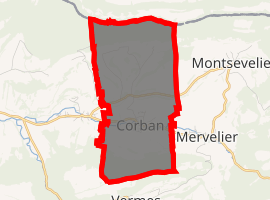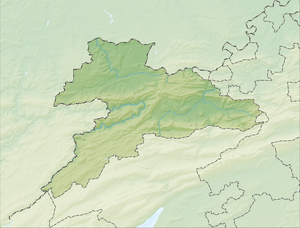Corban, Switzerland
Corban is a former municipality in the district of Delémont in the canton of Jura in Switzerland. On 1 January 2018 the former municipality of Corban merged into the municipality of Val Terbi.
Corban | |
|---|---|
Corban village | |
 Coat of arms | |
Location of Corban 
| |
 Corban  Corban | |
| Coordinates: 47°21′N 07°28′E | |
| Country | Switzerland |
| Canton | Jura |
| District | Delémont |
| Government | |
| • Mayor | Maire |
| Area | |
| • Total | 7.87 km2 (3.04 sq mi) |
| Elevation | 525 m (1,722 ft) |
| Population (2017-12-31)[2] | |
| • Total | 481 |
| • Density | 61/km2 (160/sq mi) |
| Postal code | 2826 |
| SFOS number | 6705 |
| Surrounded by | Courchapoix, Vermes, Mervelier, Montsevelier, Bärschwil(SO) |
| Website | SFSO statistics |
History
Corban is first mentioned in 1184 as Bathendorf. In 1240 it was mentioned as Corpaon.[3]
Geography

Corban has an area of 7.85 km2 (3.03 sq mi).[4] Of this area, 4.91 km2 (1.90 sq mi) or 62.5% is used for agricultural purposes, while 2.6 km2 (1.0 sq mi) or 33.1% is forested. Of the rest of the land, 0.35 km2 (0.14 sq mi) or 4.5% is settled (buildings or roads), 0.01 km2 (2.5 acres) or 0.1% is either rivers or lakes and 0.02 km2 (4.9 acres) or 0.3% is unproductive land.[5]
Of the built up area, housing and buildings made up 2.7% and transportation infrastructure made up 1.4%. Out of the forested land, 31.8% of the total land area is heavily forested and 1.3% is covered with orchards or small clusters of trees. Of the agricultural land, 40.0% is used for growing crops and 21.5% is pastures. All the water in the municipality is flowing water.[5]
The municipality is located in the Delemont district, in the eastern part of the Val Terbi.
The municipalities of Corban, Courchapoix, Courroux, Mervelier, Montsevelier, Vermes and Vicques are considering a merger on at a date in the future into the new municipality of Val Terbi.[6]
Coat of arms
The blazon of the municipal coat of arms is Azure, a Bend Argent. In 2004, 2 caterpillars were re-added to the coat of arms.[7]
Demographics
Corban has a population (as of December 2018) of 465.[8] As of 2008, 3.6% of the population are resident foreign nationals.[9] Over the last 10 years (2000–2010) the population has changed at a rate of 1.5%. Migration accounted for 1.7%, while births and deaths accounted for 2.7%.[10]
Most of the population (as of 2000) speaks French (424 or 93.8%) as their first language, German is the second most common (23 or 5.1%) and Italian is the third (2 or 0.4%).[11]
As of 2008, the population was 50.6% male and 49.4% female. The population was made up of 238 Swiss men (49.2% of the population) and 7 (1.4%) non-Swiss men. There were 226 Swiss women (46.7%) and 13 (2.7%) non-Swiss women.[12] Of the population in the municipality, 223 or about 49.3% were born in Corban and lived there in 2000. There were 153 or 33.8% who were born in the same canton, while 48 or 10.6% were born somewhere else in Switzerland, and 20 or 4.4% were born outside of Switzerland.[11]
As of 2000, children and teenagers (0–19 years old) make up 29.2% of the population, while adults (20–64 years old) make up 56.6% and seniors (over 64 years old) make up 14.2%.[10]
As of 2000, there were 192 people who were single and never married in the municipality. There were 232 married individuals, 22 widows or widowers and 6 individuals who are divorced.[11]
As of 2000, there were 168 private households in the municipality, and an average of 2.6 persons per household.[10] There were 38 households that consist of only one person and 17 households with five or more people. In 2000, a total of 158 apartments (91.3% of the total) were permanently occupied, while 8 apartments (4.6%) were seasonally occupied and 7 apartments (4.0%) were empty.[13] As of 2009, the construction rate of new housing units was 2.1 new units per 1000 residents.[10] The vacancy rate for the municipality, in 2010, was 2.67%.[10]
The historical population is given in the following chart:[3][14]

Sights
The entire village of Corban is designated as part of the Inventory of Swiss Heritage Sites[15]
Politics
In the 2007 federal election the most popular party was the SPS which received 39.02% of the vote. The next three most popular parties were the CVP (32.75%), the SVP (17.77%) and the FDP (5.92%). In the federal election, a total of 145 votes were cast, and the voter turnout was 40.1%.[16]
Economy
As of 2010, Corban had an unemployment rate of 3.3%. As of 2008, there were 29 people employed in the primary economic sector and about 12 businesses involved in this sector. 14 people were employed in the secondary sector and there were 5 businesses in this sector. 17 people were employed in the tertiary sector, with 4 businesses in this sector.[10] There were 219 residents of the municipality who were employed in some capacity, of which females made up 37.4% of the workforce.
In 2008 the total number of full-time equivalent jobs was 50. The number of jobs in the primary sector was 25, all of which were in agriculture. The number of jobs in the secondary sector was 13 of which 1 was in manufacturing and 12 (92.3%) were in construction. The number of jobs in the tertiary sector was 12. In the tertiary sector; 1 was in the sale or repair of motor vehicles, 3 or 25.0% were in a hotel or restaurant, and 6 or 50.0% were in education.[17]
In 2000, there were 10 workers who commuted into the municipality and 175 workers who commuted away. The municipality is a net exporter of workers, with about 17.5 workers leaving the municipality for every one entering.[18] Of the working population, 14.6% used public transportation to get to work, and 67.6% used a private car.[10]
Religion
From the 2000 census, 381 or 84.3% were Roman Catholic, while 39 or 8.6% belonged to the Swiss Reformed Church. Of the rest of the population, there was 1 individual who belongs to another Christian church. There were 5 (or about 1.11% of the population) who were Islamic. There was 1 person who was Buddhist. 18 (or about 3.98% of the population) belonged to no church, are agnostic or atheist, and 7 individuals (or about 1.55% of the population) did not answer the question.[11]
Education
In Corban about 157 or (34.7%) of the population have completed non-mandatory upper secondary education, and 26 or (5.8%) have completed additional higher education (either university or a Fachhochschule). Of the 26 who completed tertiary schooling, 73.1% were Swiss men, 26.9% were Swiss women.[11]
The Canton of Jura school system provides two year of non-obligatory Kindergarten, followed by six years of Primary school. This is followed by three years of obligatory lower Secondary school where the students are separated according to ability and aptitude. Following the lower Secondary students may attend a three or four year optional upper Secondary school followed by some form of Tertiary school or they may enter an apprenticeship.[19]
During the 2009-10 school year, there were a total of 45 students attending 4 classes in Corban. There was one kindergarten class with a total of 15 students in the municipality.[20] The municipality had 2.5 primary classes and 30 students.[21] There are only nine Secondary schools in the canton, so all the students from Corban attend their secondary school in another municipality.
As of 2000, there were 41 students from Corban who attended schools outside the municipality.[18]
References
- "Arealstatistik Standard - Gemeinden nach 4 Hauptbereichen". Federal Statistical Office. Retrieved 13 January 2019.
- "Bilanz der ständigen Wohnbevölkerung nach institutionellen Gliederungen, Staatsangehörigkeit (Kategorie), Geschlecht und demographischen Komponenten". Federal Statistical Office. Retrieved 12 January 2019.
- Corban in German, French and Italian in the online Historical Dictionary of Switzerland.
- Arealstatistik Standard - Gemeindedaten nach 4 Hauptbereichen
- Swiss Federal Statistical Office-Land Use Statistics 2009 data (in German) accessed 25 March 2010
- Amtliches Gemeindeverzeichnis der Schweiz Archived May 13, 2016, at the Wayback Machine published by the Swiss Federal Statistical Office (in German) accessed 17 February 2011
- Flags of the World.com Archived March 4, 2016, at the Wayback Machine accessed 20-December-2011
- Swiss Federal Statistical Office - STAT-TAB, online database – Ständige und nichtständige Wohnbevölkerung nach institutionellen Gliederungen, Geburtsort und Staatsangehörigkeit (in German) accessed 23 September 2019
- Swiss Federal Statistical Office - Superweb database - Gemeinde Statistics 1981-2008 Archived June 28, 2010, at the Wayback Machine (in German) accessed 19 June 2010
- Swiss Federal Statistical Office Archived January 5, 2016, at the Wayback Machine accessed 20-December-2011
- STAT-TAB Datenwürfel für Thema 40.3 - 2000 Archived April 9, 2014, at the Wayback Machine (in German) accessed 2 February 2011
- Canton Jura Statistics- Population résidante permanente au 1er janvier 2010, canton du Jura et communes Archived April 26, 2012, at the Wayback Machine (in French) accessed 2 March 2011
- Swiss Federal Statistical Office STAT-TAB - Datenwürfel für Thema 09.2 - Gebäude und Wohnungen Archived September 7, 2014, at the Wayback Machine (in German) accessed 28 January 2011
- Swiss Federal Statistical Office STAT-TAB Bevölkerungsentwicklung nach Region, 1850-2000 Archived September 30, 2014, at the Wayback Machine (in German) accessed 29 January 2011
- "Kantonsliste A-Objekte". KGS Inventar (in German). Federal Office of Civil Protection. 2009. Archived from the original on 28 June 2010. Retrieved 25 April 2011.
- Swiss Federal Statistical Office, Nationalratswahlen 2007: Stärke der Parteien und Wahlbeteiligung, nach Gemeinden/Bezirk/Canton Archived May 14, 2015, at the Wayback Machine (in German) accessed 28 May 2010
- Swiss Federal Statistical Office STAT-TAB Betriebszählung: Arbeitsstätten nach Gemeinde und NOGA 2008 (Abschnitte), Sektoren 1-3 Archived December 25, 2014, at the Wayback Machine (in German) accessed 28 January 2011
- Swiss Federal Statistical Office - Statweb (in German) accessed 24 June 2010
- EDK/CDIP/IDES (2010). Kantonale Schulstrukturen in der Schweiz und im Fürstentum Liechtenstein / Structures Scolaires Cantonales en Suisse et Dans la Principauté du Liechtenstein (PDF) (Report). Retrieved 24 June 2010.
- Effectifs de l'école enfantine 2009-2010 Archived April 14, 2012, at the Wayback Machine (in French) accessed 19 December 2011
- Effectifs de l'école primaire (in French) accessed 19 December 2011
External links
| Wikimedia Commons has media related to Corban. |
- Corban, Switzerland in German, French and Italian in the online Historical Dictionary of Switzerland.